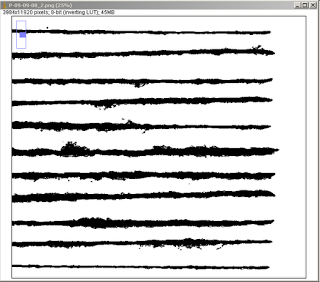It really is amazing how much time a single small macro can gobble up.
Especially if, when you are almost through, you decide that the process might be even better suited to the aims if done a little differently. Because it does make a difference whether you run a median filter first, or whether you filter out outliers first, or make a transformation to binary first and run filters later on.
Anyways, I now have a method to turn a scan of thread samples like this:
into this:
and then read out the thread thickness of every single one of these threads.
Now I only need to wrangle the gazillions of datapoints into something resembling histograms or some other form of legible visualisation. And be amazed again at how much time a single little spinning experiment can eat.
Especially if, when you are almost through, you decide that the process might be even better suited to the aims if done a little differently. Because it does make a difference whether you run a median filter first, or whether you filter out outliers first, or make a transformation to binary first and run filters later on.
Anyways, I now have a method to turn a scan of thread samples like this:
into this:
and then read out the thread thickness of every single one of these threads.
Now I only need to wrangle the gazillions of datapoints into something resembling histograms or some other form of legible visualisation. And be amazed again at how much time a single little spinning experiment can eat.





